Honolulu
‘Death Trap’: Here’s What Happened When A Diamond Head Mom Bought A Street
The City and County of Honolulu is preparing to take over Leahi Avenue after a two-year tug of war that left neighbors fuming
By Kirstin Downey / July 21, 2022
A ferocious community fight on the slopes of Diamond Head may be coming to a close.
The dispute over one of the area’s main thoroughfares unfolded in an exclusive enclave of multimillion-dollar single-family homes and an interior cluster of about 400 more modest apartments and condominiums, in a residential area nestled along Kapiolani Park.
After two acrimonious years, a resolution is pending, with the city preparing to take possession of Leahi Avenue from the woman who bought it, according to city officials.
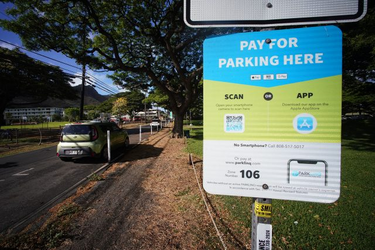 The arrival of pay-for-parking signs on Leahi Avenue shocked local residents, some of whom had been parking there for decades.
The arrival of pay-for-parking signs on Leahi Avenue shocked local residents, some of whom had been parking there for decades.
Cory Lum/Civil Beat/2022
The troubles began in 2018 when a well-connected Diamond Head matron, Mary Moriarty Jones, decided her children needed a sidewalk to walk safely on Leahi Avenue to Waikiki Elementary School.
Many of her neighbors agreed that sidewalks would be desirable along the unimproved street, with its dirt shoulders and lack of drainage controls. Parked cars lined the street, day and night.
The lack of sidewalks is a common problem on an island with more than 800 miles of what are called “private roads,” byways that are often maintained by the city but are not part of the designated road network. Some of these streets are intentionally private, like at Turtle Bay Resort, but others are relics of the past. Some were built during the plantation era by firms that are long defunct.
Kaimuki, for example, has more than 70 private roads, said Lori Yamada, secretary of the Kaimuki Neighborhood Board, adding that the lack of sidewalks poses a safety risk for kids walking to Kaimuki Middle School. The developer who built the roads, Palolo Land and Improvement, went out of business in 1946.
Improving private roads across Oahu would be prohibitively expensive and require the city to accept liability for streets that do not meet city code, city officials say.
Leahi Avenue was built in the 19th century when people traveled places on foot or on horseback. The stretch in question is about a third of a mile long, parallel to Paki Avenue on the edge of Kapiolani Park, running from Noela Street to Monsarrat Avenue, a hub for tourists climbing Diamond Head.
It also houses Oahu’s lifeguard headquarters, a popular community garden and Waikiki Elementary School, a top-ranked public school attended by some 550 children.
Jones and other members of the Diamond Head/Kapahulu/St. Louis Heights Neighborhood Board raised concerns about safety and child access with city officials. Jones was later named a member of a “permitted interaction group,” a subcommittee set up by the board to focus on the problem. Residents wanted the city to take over the road and make improvements to it.
Officials with the administration of then-Mayor Kirk Caldwell told them this was impossible. Jones and other residents were informed it was long-established city policy not to accept responsibility for private roads unless they were first upgraded at someone else’s expense.
City officials now say it would cost $30 million to bring Leahi Avenue to acceptable city standards.
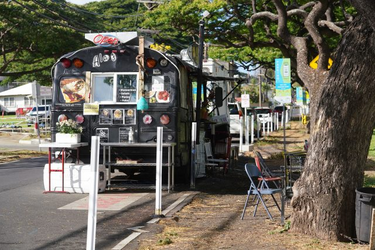 Food trucks parked along Leahi Avenue, across the street from Waikiki Elementary School.
Food trucks parked along Leahi Avenue, across the street from Waikiki Elementary School.
Cory Lum/Civil Beat/2022
Then Jones had what she told Civil Beat in 2020 was a “
brilliant idea.”
She decided to buy the street herself and make changes on her own. She did some research and decided that Lunalilo Trust was the legacy owner of the street, information that was unwelcome news to Lunalilo Trust. Formed from the once-vast estate of Hawaiian
King William Charles Lunalilo, who died in 1874, the trust’s remaining resources are dedicated to
operating a nursing home for Native Hawaiians.
Others are not so clear that the chain of title stretches unbroken to Lunalilo. City investigations of the property’s provenance and title guarantee reports have come to differing conclusions.
Nevertheless, on Oct. 6, 2020, Jones
obtained a quit-claim deed from Lunalilo for $10 that released Lunalilo from any liability for the street and transferred it to Safe Leahi, a limited liability corporation Jones had established. It gave Jones control of the street for vehicular and pedestrian access. It forbade Safe Leahi from charging tolls to use the road but specifically said she could charge parking fees to pay for roadway operations.
If the city were to accept the street as a public road, the deed would terminate automatically, according to the document.
With that action, a public street became private property that belonged exclusively to Jones.
 Mary Moriarity Jones bought Leahi Avenue after unsuccessful efforts to get the city to take over the road.
Mary Moriarity Jones bought Leahi Avenue after unsuccessful efforts to get the city to take over the road.
Cory Lum/Civil Beat/2020
Jones quickly put up signs and turned the two-way street into a one-lane road with traffic permitted to travel in both directions. She established tow-away zones along the road where her neighbors in the multifamily housing had parked their cars. She also reduced the speed limit from 25 miles per hour to 15.
Then she
began renting out parking stalls, charging $1.25 an hour, $12 a day and $150 a month. She eventually expanded her commercial ventures to include food trucks, which she allowed to park outside Waikiki Elementary School, and later introduced rental scooters.
The reaction in the community was “near universal outrage,” Leahi Avenue resident Dana Bergeman told city officials during a meeting last fall. Michelle Matson, another resident, compared it to being “held hostage.”
What had once been viewed as a benevolent effort to improve safety came to be seen by neighbors as a money-making venture with adverse consequences.
“While Mary Jones’ initial sentiment and intentions may have been noble, she has proven herself to be a tyrant,” James Yoshimura told city officials. “The story of the troll underneath the bridge guarding it comes to mind.”
The situation has
similarities to that of the Chun Brothers, who got control of a network of Kakaako and Waikiki streets starting in the 1980s and, using quit-claim deeds from the families of long-dead Hawaiians, asserted ownership of the streets, charging businesses and residents for parking and towing away cars that did not pay up. Years of litigation followed. The brothers
are now being sued by the state Attorney General’s Office.
Jones did not respond to telephone calls and emails asking for her perspective. Her attorney, Cal Chipcase of law firm Cades Schutte, declined to comment.
At the beginning, Jones was lionized in some circles for her moxie in taking on city hall. In a
podcast interview, Jones explained what she had done and said she had to charge for parking to pay for her desired improvements.
She never built any new sidewalks.
For scores of her neighbors, the situation was infuriating. Traffic became badly congested and backed up each day at the entrance to Waikiki Elementary as buses and parents delivered their kids to what had become a one-lane road.
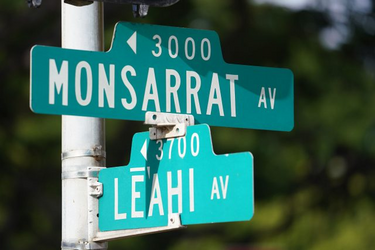 Traffic snarls have become a daily occurrence during days when Waikiki Elementary School is open.
Traffic snarls have become a daily occurrence during days when Waikiki Elementary School is open.
Cory Lum/Civil Beat/2022
Almost 1,000 people in the Pualei Circle complex of apartments lost access to parking on Leahi Avenue, said Linda Wong, a long-time board member. Apartments built with one parking space now often house two or three wage-earners and residents there parked on the street. Under Jones’ orders, unauthorized cars were towed away and owners had to pay to recover them.
“People had to move out who didn’t have parking,” Wong said.
The narrowing of the road, with hulking and dilapidated food trucks blocking visibility at Monsarrat and Leahi, made passage there more perilous, residents and city officials said.
Cars turning onto Leahi Avenue were trapped between the food trucks and oncoming traffic, forced to duck into whatever empty parking space they could find to avoid head-on collisions. Some described it as a high-tension game of chicken when drivers coming the other way refused to yield.
“It felt like a death trap,” Linda Woodstock told the City Council last year.
The city’s traffic engineers agreed that some of the changes made the street more dangerous.
“The trucks that blocked the site views were not a safety improvement at all,” said Roger Morton, director of the city’s Department of Transportation Services. “The commercialization by putting private scooters and food trucks that would otherwise not be allowed was something I don’t think was appropriate.”
Changes to the street configuration made logistics more difficult and problematic for the island’s Ocean Safety and Lifeguard Services Division, which has its headquarters and base of operations there.
“Prior to the privatization of the street, it was relatively easy to come and go,” Ocean Safety chief John Titchen said. “We, as a public safety agency, have had to make accommodations to exist.”
Ryan Kusuda, principal of Waikiki Elementary School, attended many community meetings, adding his pleas for help. Kusuda said he was forced to deploy his entire 100-person staff each morning and evening to direct traffic and help children arrive safely.
“It took what had been a very peaceful community and brought out the worst in people.” — Managing Director Mike Formby
Neighbors reported a rise in altercations, with people screaming and gesturing angrily at each other.
“I’ve heard road rage going on,” said Arleen Velasco, whose home overlooks Leahi Avenue. “I’ve seen men getting out of their cars to square off.”
The neighborhood board swung into action through 2020 and 2021. Andrew Salenger, a resident whose day job is in the state AG’s office, took over as chair. They prepared resolutions asking for the city’s help.
The board formed a Leahi Avenue committee and peppered elected city officials with requests for help and updates about the deteriorating situation. Many questioned the role of City Council Chair Tommy Waters, who represents their district, and shared suspicions that he had helped Jones acquire the road.
They also requested government records to determine how Jones had gained access to the quit-claim deed. They found that Waters had joined Jones at a meeting with Lunalilo Trust officials at Honolulu Hale on Aug. 26, 2019, which they believed showed that Waters was directly assisting Jones and giving her actions the appearance of government authorization.
In an interview, Waters said he had long been acquainted with Mary’s husband, Kalau, who is a member of a large local family based in Kuliouou, but that he had never met Mary until he was walking the district while campaigning in 2018.
He said he talked to Mary, who he said was “super passionate” about the issue of child safety on Leahi Avenue, a concern he shared.
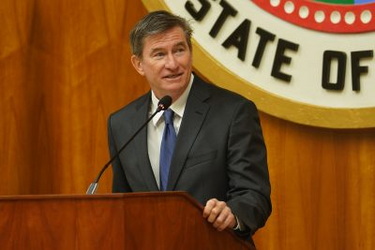 Honolulu City Council chair Tommy Waters’ role became a matter of controversy.
Honolulu City Council chair Tommy Waters’ role became a matter of controversy.
Cory Lum/Civil Beat/2022
When Waters got elected, he said, he considered it a “campaign promise” to look into the issue and discovered long-standing concerns about Leahi Avenue. He said he asked the Caldwell administration to take over the street and make the necessary improvements.
The officials told him no because the street was not on a priority list of projects under consideration.
“I hit a brick wall,” he said, adding that he took no further action. He said Jones decided on her own to take control of the road. He learned what had happened when angry calls and emails began flooding his office in October 2020, he said.
Waters said when he contacted Lunalilo officials to inquire about what had happened, they apologized for having made the decision in summer 2020, while coping with the stress of Covid at the senior-care facility, to simply grant the quit-claim deed to Jones without telling him.
He said it is unfair to blame him.
“I have been accused of being in cahoots with Mary, that I was part of this whole scheme, and that’s just not true. Ultimately I wanted the same thing that Mary wanted, which was a sidewalk for the kids. But I would never have dreamed of going through this process, right, I tried my best with the Caldwell administration.”
Once Mayor Rick Blangiardi came into office, Waters said, he sought to rectify the situation,
introducing a resolution for the city to buy the road, calling the situation that had resulted a “motorist nightmare.” It passed in October 2021.
At the hearing in which the measure was introduced, other council members pointedly referred to similar problems in their own districts before backing Waters in his request.
The issue fell into the laps of newly appointed mayoral officials. Swamped by calls from still-angry Diamond Head residents, Blangiardi asked Mike Formby, his managing director, and Morton, the transportation director, to find a solution.
While sympathetic to the neighborhood’s problems, the situation was complicated, Formby and Morton said in an interview last week. They were trying to find a path forward that was “equitable and fair,” because so many neighborhoods have issues with private roads but have to wait in line to get attention from the city.
Ultimately, however, they decided that the fact that the street houses a school and two city facilities, the lifeguard headquarters and the community garden, made it “very unusual” and allowed them to give Leahi Avenue precedence over other areas.
They also witnessed the neighborhood turmoil for themselves when they visited Leahi Avenue to see what was happening and quickly realized the issue had become “hugely polarizing,” Formby said.
“Really, when we were out there people were leaving very uncivil notes and messages on other people’s cars, they were doing all sorts of stuff like yelling obscenities when they would drive by,” he said. “It took what had been a very peaceful community and brought out the worst in people. And we felt like at some point you need to get in there and resolve it. There’s no win-win in that situation.”
Formby said he is negotiating with Jones’ attorney to draft a quit-claim deed by which Jones will give the street to the city. He is also preparing what he called a “statement of assurance” that will allow Jones to file a claim with the city for any losses or expenses she says she has incurred.
Morton said that as soon as the quit-claim deed is filed, he will write to Jones and tell her to evict the food trucks. The city will remove Jones’ signs and install standard traffic-control signs. The speed limit will be increased to 25 mph, the city standard.
After three months, he said, the city will conduct engineering studies to see what changes to the road are warranted.
City officials hope to transfer the road to city ownership within a few weeks or months.
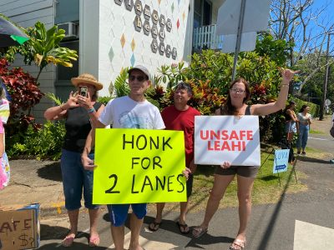 Some residents protested the plan to slow traffic on Leahi Avenue by turning it into a one-lane road.
Some residents protested the plan to slow traffic on Leahi Avenue by turning it into a one-lane road.
Denby Fawcett/Civil Beat/2021
The situation has soured some area residents on Waters, who is running for reelection.
“I think Tommy Waters has been untruthful to us,” said Velasco, a Diamond Head resident for 10 years, saying she would not vote for him now.
Others were more equivocal.
“I support and still support Waters overall … but I have questions about why he has been so quiet about Leahi,” Matson said.
Waters said he felt “terrible” for the people who lost their parking and his only intention had been to build a sidewalk because he “was worried about the kids walking in the street.”
Waters said he hopes the city gets control of the street quickly because he knows some voters are unhappy with him.
“I sure hope it gets done before the election, but ultimately I will cross my fingers, but who knows? People can vote their conscience. I feel good. If I lose the election, it’s disappointing but I can sleep at night because I really want the city to take over this road and make it as safe as possible,” he said.


























